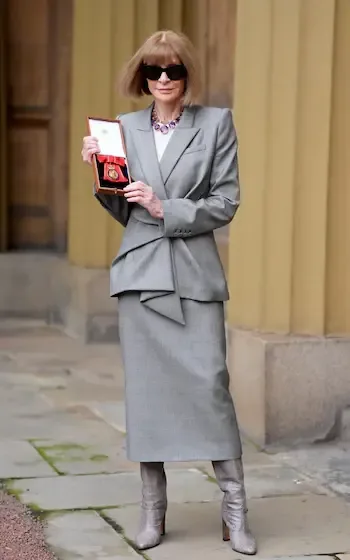When Dame Anna Wintour received her prestigious Companion of Honor award for her indelible contributions to the fashion industry from King Charles III, her sartorial choice was nothing short of emblematic. The American Vogue editor-in-chief, a paragon of sartorial authority, opted for a grey Alexander McQueen ensemble in the iconic Prince of Wales check, a pattern steeped in regal heritage and timeless sophistication. The tailored suit, featuring a calf-length pencil skirt and an asymmetrically hemmed jacket, epitomized modern elegance with a nod to British tradition. Wintour was accessorized with knee-high snakeskin boots, her trademark dark sunglasses, and a striking amethyst necklace reportedly once owned by Queen Mary, yet the Prince of Wales check commanded attention, underscoring its enduring relevance in the fashion lexicon.

The Princess of Wales further underscored the pattern’s royal pedigree, who recently revisited her beloved black-and-white check Zara midi dress during a visit to Tŷ Hafan Children’s Hospice in the Vale of Glamorgan. This £89.99 piece, a testament to accessible luxury, has become a cornerstone of the Princess’s wardrobe. First debuted in 2020 during a community engagement in Bradford, the dress has been repeatedly reimagined for royal appearances, exemplifying the versatility and enduring appeal of the Prince of Wales check.
The pattern’s storied history is punctuated by iconic moments in fashion and film. Princess Diana, a perennial style icon, elevated its power-dressing potential in 1988 by pairing a double-breasted check blazer with a white roll-neck and a monogrammed Fendi clutch. Similarly, Julie Christie’s chic outerwear in the 1973 film Don’t Look Now and Cate Blanchett’s red carpet appearance in a plunging neckline check suit has cemented its status as a sartorial staple. Designers, too, have consistently embraced the pattern, with Saint Laurent’s recent foray into masculine tailoring and Gucci’s recurring wool blazer collections showcasing its adaptability across genders and aesthetics.
Originating not in Wales but in Lewiston, Scotland, the pattern was first woven by Elizabeth MacDougall and later adopted by the Countess of Seafield for her estate staff in Glenurquhart Valley. Officially registered as the “Glenurquhart Estate Check” in 1840, it gained royal cachet when Edward VII championed its use, leading to its current nomenclature. Despite its historical roots, the pattern remains remarkably contemporary, offering a refreshing alternative to the formality of navy or black without sacrificing sophistication.
Stylist Annabel Hodin emphasizes the pattern’s versatility, noting its ability to balance structure with softness. “The Prince of Wales check is the epitome of chic versatility,” she explains. “It provides a sophisticated yet approachable alternative to darker tones, making it ideal for both formal and casual settings.” Hodin suggests modern styling techniques to rejuvenate the classic pattern, such as pairing a check blazer with denim for an effortless spring ensemble. She advises, “A cream top beneath the check can brighten the complexion, as seen on Wintour. However, avoid roll-necks, as the pattern’s weight can overwhelm opt for round or bow-neck styles instead.”
For those seeking to incorporate this timeless print into their wardrobe, the high street offers a plethora of options. From tailored blazers to midi dresses, the Prince of Wales check continues to resonate across fashion tiers, proving its enduring relevance in an ever-evolving industry. Its ability to transcend eras, occasions, and styles ensures its place as a perennial favorite among fashion connoisseurs and royal wardrobes alike.

